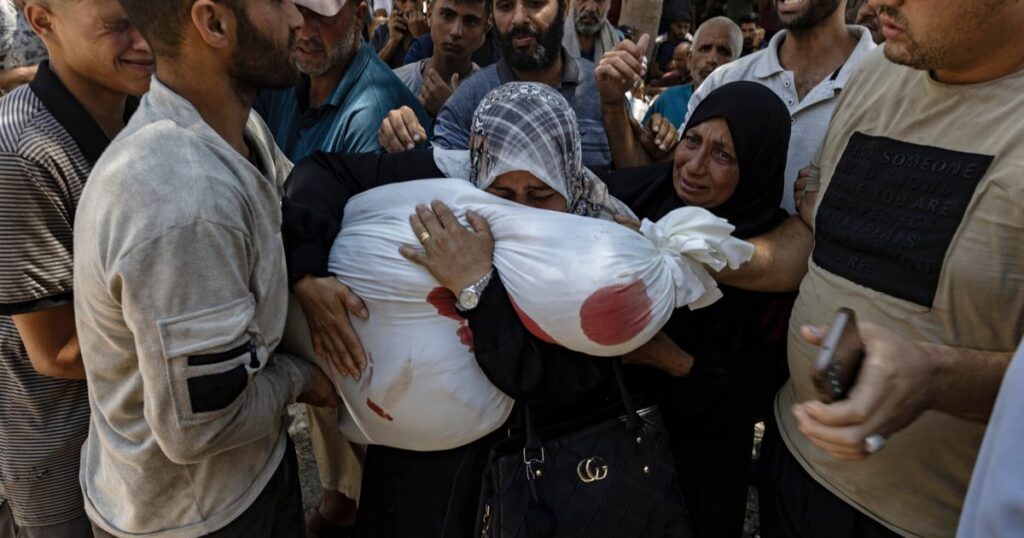JERUSALEM — For a year and a half, experts have warned that Israel’s failure to plan for a power transition in the Gaza Strip would lead to anarchy, make it harder to deliver aid and stymie efforts to defeat Hamas.
A sequence of shootings in Gaza over the weekend — one near Gaza’s southern border, another at its northern edge — have highlighted the accuracy of those predictions.
On Saturday, Israeli soldiers opened fire on civilians who were moving chaotically toward food distribution sites run by Israeli-backed private contractors in Israeli-controlled areas. On Sunday, Israeli soldiers opened fire on civilians who were rushing to seize aid from a convoy of food trucks sent by the United Nations toward areas controlled by Hamas. The Israeli military said its soldiers had fired “warning shots” to deter people who posed a “threat.”
Supporters of the Israeli-backed system used the episode Sunday to highlight the failures of the U.N.-led system. Those favoring the U.N. system said the killings Saturday illustrated the failures of Israel’s approach.
Israel says it is necessary to put food distribution sites in areas beyond Hamas’ control in order to make it harder for both fighters from the militant group and civilian looters to steal supplies. Critics of that approach say it forces hungry civilians to cross Israeli military lines, putting them at greater risk.
But these critiques skirt around a broader problem. Both aid systems are piecemeal responses to a failure by Israel to make detailed plans for a transition of power in Gaza, according to analysts and experts on aid distribution.
Israel has devastated much of the territory, destroyed much of its infrastructure, decimated Hamas’ leadership and hindered its ability to provide social services and law enforcement in most of the territory.
Prime Minister Benjamin Netanyahu of Israel has also repeatedly decided against creating a system of transitional governance — whether through formal military occupation or the empowerment of Palestinian alternatives to Hamas. In particular, he has prevented the return of the Palestinian Authority, which governed the territory until Hamas seized power in 2007.
The upshot is that, after nearly two years of war, much of Gaza has no functional governing system. That has led to chaos in much of the territory, on both the way to the Israeli-backed aid sites and along the routes used by U.N. convoys.
Compounding the situation, Israeli soldiers are repeatedly using live fire to contain unrest, instead of using nonlethal forms of crowd control. And amid widespread food shortages after Israel’s aid blockade between March and May, civilians are also ready to risk death by Israeli gunfire to avoid death by starvation.
“There’s a blame game, and everyone is looking at the technical details and about how the aid is distributed,” said Shira Efron, an expert on aid systems in Gaza at Israel Policy Forum, a research group in New York.
“But the bigger issue is the lawlessness and the breakdown of governance,” she added. “After 22 months of war, it’s anarchy in Gaza. And without addressing the core issue of what should happen next in Gaza, there won’t be a solution.”
That failure to find a solution has led to Israel’s growing diplomatic isolation. On Monday, 25 countries, including Britain, France and Japan, called Israel’s conduct “unacceptable” and demanded that Israel end the war immediately.
Netanyahu has said Hamas must be completely defeated before detailed postwar plans can begin. But his critics, including many in Israel, say it is harder to defeat Hamas without planning for its replacement.
The risks of failing to plan for postwar Gaza were made clear to Netanyahu and his colleagues in the earliest weeks of the war in late 2023, when U.S. officials and Israeli generals pushed him to map out the war’s endgame.
Under pressure from far-right allies, who seek to reestablish long-term Israeli control over Gaza, Netanyahu avoided firming up any plan that involved empowering the Palestinian Authority.
By March 2024, the consequences of that decision became clear when, amid growing lawlessness and hunger, Israeli soldiers shot and killed Palestinians trying to seize food from an aid convoy in northern Gaza, in an incident that also prompted a stampede.
At that time, both Israeli and Palestinian analysts warned that the power vacuum in Gaza made such episodes more likely, since it was already becoming hard to coordinate the distribution of food and protect food convoys. They also warned that without a power transition, the void would be filled by looters and gangs — or by a reconstituted Hamas.
Almost exactly a year later, with the governance vacuum persisting, Israel exacerbated the situation by blocking all food and fuel deliveries to the enclave. That led to even greater food shortages, bringing Gaza to the brink of famine.
Even in Israel, the unending nature of the country’s campaign has led critics to question whether the chaos is intentional, rather than the byproduct of bad planning.
“We control Gaza,” said Ehud Olmert, a former prime minister of Israel who has become increasingly critical of the country’s conduct in the war.
“It’s incumbent upon us to make sure that the proper arrangements are made,” Olmert said in a phone interview. “If they are not made, it’s because the Israeli government doesn’t want it to be made.”

